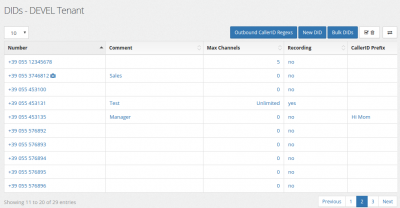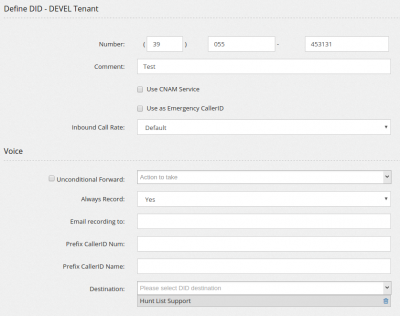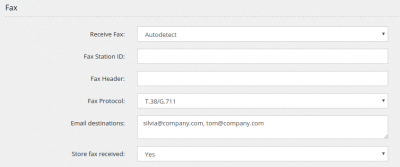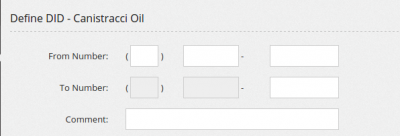DIDs

To every tenant can be assigned a group of DIDs, numbers to be dialed from the outside.
Each DID can be configured to reach a certain extension or Queue or Hunt Group or IVR or any combination of the elements defined for the tenant.
The same DID cannot be assigned to more than one tenant and there is no correlation between the dialing profile assigned to a tenant, the trunk provider used and the incoming DID.
For this reason is highly important that the incoming INVITE from the trunk provider contains all the info to identify correctly the DID it is addressing to.
Due to the fact there is a lack of strong standardization among trunk providers on how to transmit the DID information, a “best guess” is used to identify the correct DID, using any of the format currently in use around the world.
A DID can be configured to accept voice, fax or try to guess the calling party (if voice of fax).
Autodetection relies on signalling at the start of the call and cannot be always reliable.
The time to detect the fax tone can be set in Admin/Settings page.
Editing New/Define DIDs

The number must be entered in three parts, starting with international prefix, area code and number. Even if your telephone standard doesn't allow the usage of any “short” form for dialing the number, requesting for example, to dial always the area code, the number is requested to be entered this way. Using the Admin/Settings menu is possible to enable the use of a “single box DID” to just enter the number in a single box, but this is highly discouraged.
It is possible to use regular expression inside the number. In case multiple regular expressions match the number dialed, the ordering is based alphabetically on the Comment.
Comment is just a comment and it is not used in any way.
Max channels allows you to set the maximal number of channels available on the DID. Any additional call received will be refused with a busy signal.
Use CNAM service allows you to assign the Caller ID Name based on this popular service offered in most countries. You can configure the service in Admin/Settings page.
Use as Emergency CallerID permits you to mark this DID as one of the available to be used when an emergency call is dialed. Due to the fact the emergency numbers are not standard among all countries, it is your duty to assign the “emergency flag” to the dialing rules for emergency numbers. When a call is dialed and it is using a dialing rule marked as “emergency”, the Caller ID number used for the extension is the one defined as “Emergency” among the ones with this flag set.
Inbound Call Rate allows you to define a call rate for inbound calls.
Voice
This section allows to define how to route the call when a voice call is received.
Unconditional Forward is a destination that can be set on the DID to send the call to a particular destination. It is enable/disabled by the checkbox and that checkbox can be easily controlled by a feature code. This is not the destination to be set for common usage, you need to use the one in the Voice section.
Always record permits to force the recording of the call, whichever is the future of the call. Recordings will be available through the Call History menu.
Email recordings to defines if and to who the recordings needs to be sent once the call is over. Multiple destinations email can be entered with any delimiter, like space, comma and point and comma.
Minimum Size (Bytes) allows to receive those recordings bigger than the size set, in Bytes. Recording takes place only on bridged channels, so IVR prompts or Music On Hold will be not recorded.
Using the Prefix CallerID Num is possible to define a string to be added to any CallerID number received to identify for example the DID the call is coming from. The same result can be achieved by defining a Custom Destination.
Prefix CallerID Name is the same as above, but for the Caller ID Name.
Destination multiple drop down allow to define the list and the order of the objects receiving the call.
Fax
This section allows to define what to do with the call if a fax is received on the number defined. Receiving Fax over the Internet has often a low success rate, even if T.38 protocol is used.

Receive fax can be used to select if autodetect, force or disallow the reception of a Fax over the current DID.
Fax Station ID and Fax Header allows you to customize your virtual fax.
Fax Protocol can be selected among T.38 (the preferred way to receive faxes), T.38 with fallback to G.711 or only G.711.
Email destinations box permits to enter one or multiple comma delimited email address to forward the received fax. Received fax are sent in PDF format. Partially received faxes are sent in the same way.
It is possible to store the fax received for later reviewing using the Store Fax Received control.
SMS

You can specify how to pull or receive SMS on this DID.
Protocol lets you choose the protocol to be used. More info can be found in embedded help.
The SMS can be then delivered to a SIP phone as SIP message or to any other destination.
Bulk DIDs creation

It is possible to create multiple DIDs at once with Bulk DIDs creation button.
In this way a range of number is requested.
All the generated numbers are configured in the same way.
Use DIDs storage

In the Admin/Settings page is possible to choose to use the DIDs storage.
In this way the DIDs needs to be entered by the Admin/DIDs List menu and can be later chosen using a drop down box from the Define DID page.
DIDs cannot be deleted, but they are just not assigned to any tenant.
Outbound CallerID Regex

DIDs are used by extensions as CallerID, but it is possible to select a Regex to pickup the most useful CallerID for that call, so you may use your italian office CallerID when dialing to Italy or your american one when dialing to US.
If your profile allows you to use customized CallerID, you can enter the CallerID number of your choice.